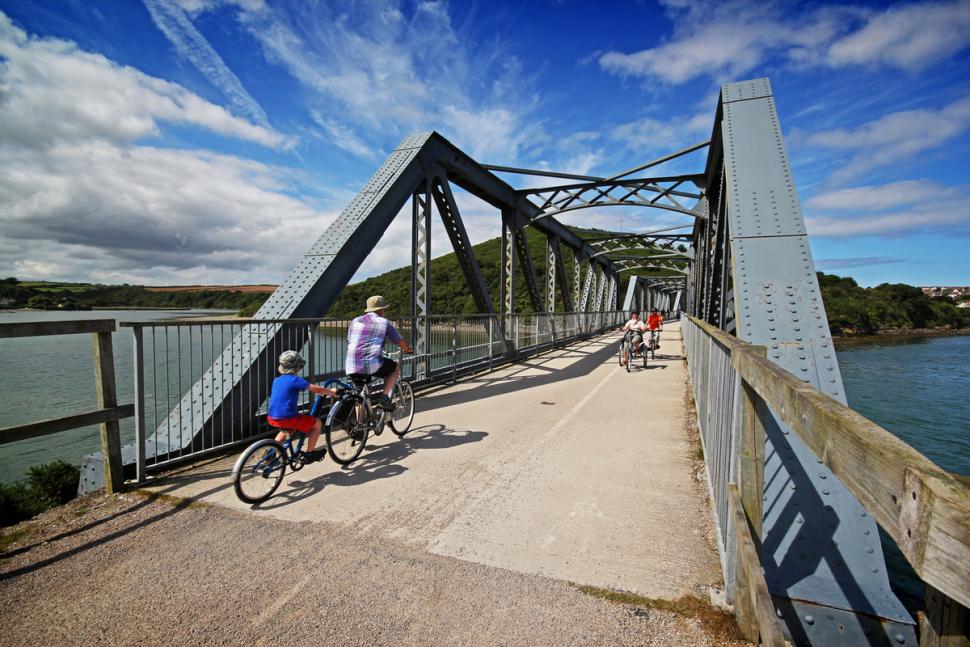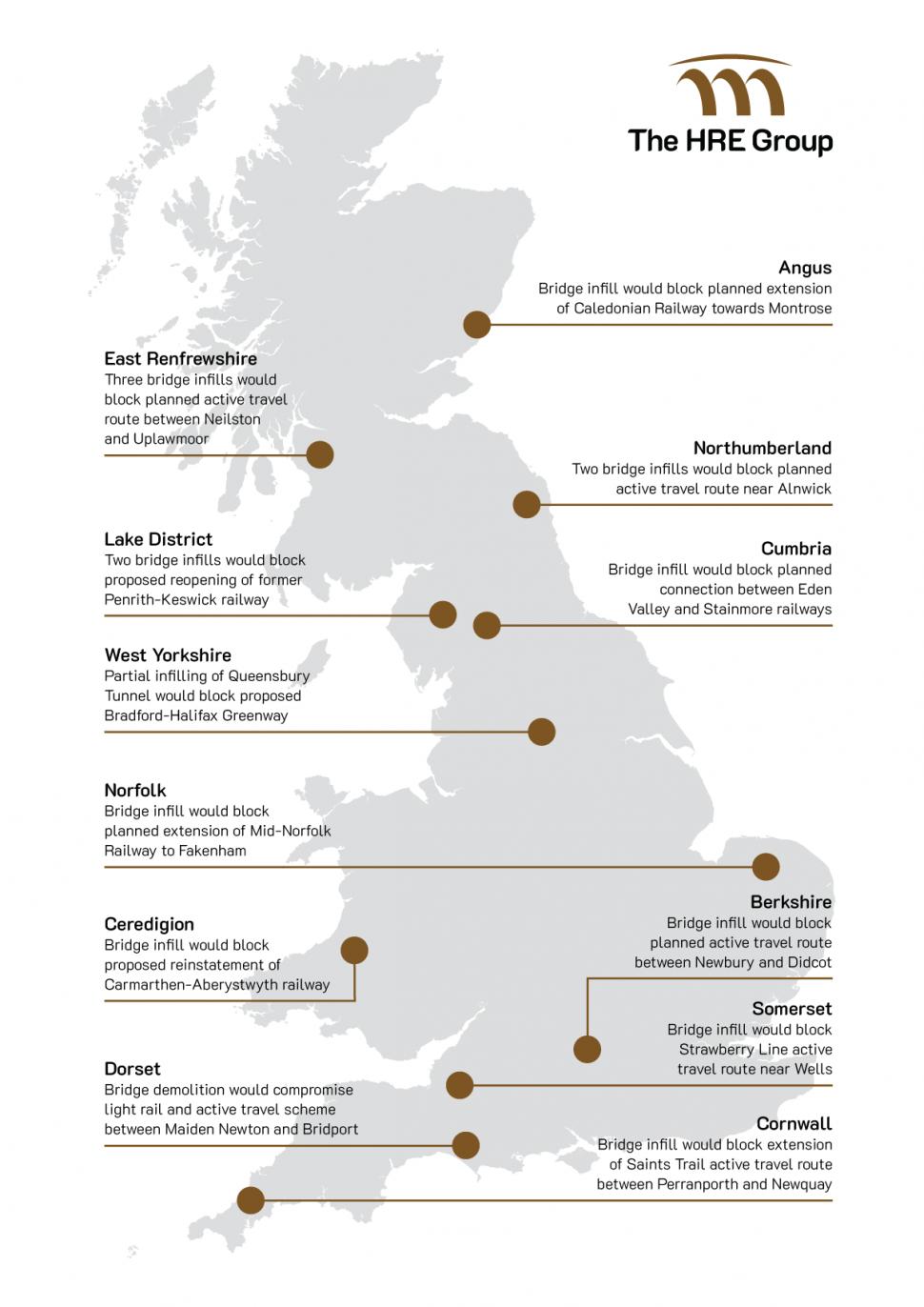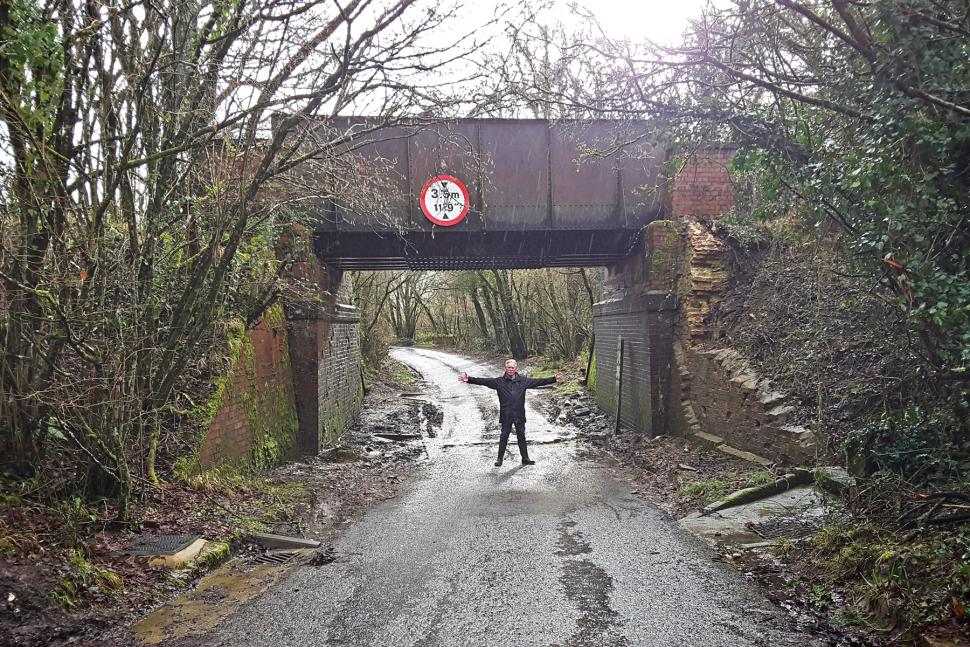- News
- Reviews
- Bikes
- Accessories
- Accessories - misc
- Computer mounts
- Bags
- Bar ends
- Bike bags & cases
- Bottle cages
- Bottles
- Cameras
- Car racks
- Child seats
- Computers
- Glasses
- GPS units
- Helmets
- Lights - front
- Lights - rear
- Lights - sets
- Locks
- Mirrors
- Mudguards
- Racks
- Pumps & CO2 inflators
- Puncture kits
- Reflectives
- Smart watches
- Stands and racks
- Trailers
- Clothing
- Components
- Bar tape & grips
- Bottom brackets
- Brake & gear cables
- Brake & STI levers
- Brake pads & spares
- Brakes
- Cassettes & freewheels
- Chains
- Chainsets & chainrings
- Derailleurs - front
- Derailleurs - rear
- Forks
- Gear levers & shifters
- Groupsets
- Handlebars & extensions
- Headsets
- Hubs
- Inner tubes
- Pedals
- Quick releases & skewers
- Saddles
- Seatposts
- Stems
- Wheels
- Tyres
- Health, fitness and nutrition
- Tools and workshop
- Miscellaneous
- Buyers Guides
- Features
- Forum
- Recommends
- Podcast
 Little Petherick Bridge © The HRE Group
Little Petherick Bridge © The HRE GroupHighways England accused of abusing emergency powers to demolish or infill bridges on disused railways
Government-owned Highways England has been accused of using emergency powers to demolish or infill more than 100 disused railway bridges, tunnels and viaducts that campaigners say could be given a new lease of life as part of cycle routes, reopened railways or extensions to existing heritage railway lines.
HRE Group, an alliance of engineers, cycling campaigners and greenways developers, says that Highways England, which manages the Historical Railways Estate on behalf of the Department for Transport (DfT), plans to infill or demolish some 134 bridges across Great Britain, many dating from the Victorian period and carrying or spanning railways axed in the Beeching cuts in the 1960s.
According to the campaign group, Highways England says that the bridges concerned are among 200 to have failed an engineering assessment to carry 44-tonne lorries and, in the absence of weight restrictions, will have to be infilled or demolished on “urgent safety grounds” to “prevent an emergency arising.”
But HRE Group says that 19th Century railway bridges, which make up the majority of the bridges at risk, are only required to carry 24 tonnes, and that weight restrictions are only put in place where the anticipated traffic loading is greater than the structure’s capacity. It also points out that most of bridges are in good condition, and many of them have narrow lanes so cannot be used by lorries.
It adds that plans would block the routes of six proposed cycle paths – including one near Newbury, Berkshire that is funded by Highways England itself, with others located in Cornwall, Somerset, West Yorkshire and Northumberland, and has produced a map showing some of the active travel and heritage railway routes potentially affected.
In recent decades, a number of former railway lines have been turned into active travel routes, examples including the Bristol & Bath Railway Path, the Ystwyth Trail in Ceredigion and the Deeside Way in Aberdeenshire, as well as the Camel Trail in Cornwall, which includes the Little Petherick Bridge near Padstow, pictured above.
Last month, when HRE Group first published a list of at-risk bridges, a spokesperson from Highways England, quoted on the website Newbury Today, said: “To maintain the safety of communities living near to Historic Railway Estate structures, and the drivers who use the roads that cross them, we are planning to infill 115 bridges, one of which is Hackney Bottom railway bridge.
“Local highway authorities have responsibility for applying weight or traffic restrictions or closing the road, but haven't despite the bridge having fractures increasing in size. Therefore, our planned infilling is the safest and most appropriate option and will maintain access across the structure.
“We contact all local authorities affected to advise them of our plans and to see if they have any use for the structures.”
But HRE Group, says that Highways England is using its emergency powers to circumvent planning consent which would ordinarily need to be secured to carry out infilling or demolition works, and that in 33 of 63 cases it has examined the disused railways the bridges cross are safeguarded from development under the relevant councils’ local plans, meaning that planning permission would be refused.
Matt Skidmore of HRE Group said: “The Permitted Development powers are clearly intended for situations where there is an immediate threat of an emergency, but Highways England is seeking to exploit them for routine asset management purposes.
“Some of the infilling projects are not expected to start until 2025; that’s nobody’s definition of an impending emergency.
“There are no legitimate engineering grounds for what they’re doing so these powers are being used to overcome the challenges that might otherwise arise through the planning regime,” he added.
“This is an assault both on democratic process and our railway heritage, preventing these historic structures from fulfilling a useful future role.”
The proposed demolition of a bridge in Dorset (pictured below) could add £750,000 in costs to a community project to develop a new light railway and active travel route linking Maiden Newton, which is on the national rail network, to Bridport and West Bay, says HRE Group.
Nigel Ewens, director of Jurassic Coast Railways which is leading the project, said: “The cost of building a completely new bridge to modern standards would be significantly higher than repairing the existing Victorian structure which benefits from grandfather rights. So retention is crucial.
“At a time when we’re increasingly recognising the value of green infrastructure, it’s absurd that unaccountable officials are conspiring to put beyond use assets that can be repurposed to enhance biodiversity, wellbeing, community connectivity and reduce our environmental footprint. Where’s the joined-up long-term thinking?
“The use of Permitted Development powers to drive through the desecration of these national assets without public scrutiny is a disreputable act and those in a position of influence need to act quickly to ensure a full and proper appraisal of these structures’ true value is undertaken before it is too late,” he added. “This is a call to arms.”
HRE has written to the House of Commons Transport Select Committee calling for an investigation of Highways England’s management of the Historical Railways Estate, with more than 7,500 people so far having signed a petition calling for the structures to be safeguarded.
Simon joined road.cc as news editor in 2009 and is now the site’s community editor, acting as a link between the team producing the content and our readers. A law and languages graduate, published translator and former retail analyst, he has reported on issues as diverse as cycling-related court cases, anti-doping investigations, the latest developments in the bike industry and the sport’s biggest races. Now back in London full-time after 15 years living in Oxford and Cambridge, he loves cycling along the Thames but misses having his former riding buddy, Elodie the miniature schnauzer, in the basket in front of him.
Latest Comments
- Pub bike 3 sec ago
It is understandable that people who aren't healthy don't understand about the benefits of being healthy and maintaining physical health, and how...
- Hirsute 9 min 41 sec ago
Helmet wars ! video - https://twitter.com/AmericanFietser/status/1780278529109705012
- Rendel Harris 22 min 59 sec ago
I thought the rationale for wearing sunglasses over rather than under the helmet straps was so they could fly off in a crash and not stay around to...
- john_smith 49 min 59 sec ago
Are you absolutely sure that is genuine? What do you hope to achieve by posting it here?
- IanMSpencer 2 hours 20 min ago
I don't think you need have any concern about cycling safety improving with #toxicadi Ashley Neal advocating for us on protected cycle lanes....
- mark1a 2 hours 27 min ago
Surely it's the sensor that is 8K, not the lens?
- Nagai74 2 hours 50 min ago
No proof of this, but wouldn't you imagine that the majority of drivers have ridden pushbikes at some point in their lives, even if only as kids?
- chrisonabike 2 hours 56 min ago
Indeed... though to be fair the Dutch have some contraflow cycling in narrow streets. Although I think increasingly they would try to avoid this ...
- NPlus1Bikelights 3 hours 13 min ago
The inventor of the wall mounted triangles needs to be shamed. They only take a standard bike and damage the rims. Also the wheel is secure but the...


Add new comment
14 comments
Should be fun digging out all that concrete...
https://www.theguardian.com/culture/2021/jul/21/highways-england-may-hav...
An organisation motivated by preventing people from having any alternatives to driving cars.
This is very disappointing. I really wish they would protect the old railway routes. Those lines are irreplaceable as they're usually the optimum route given the terrain.
They've sold off and built over the disused line that used to serve our town. It's now very unlikely it could ever be resurrected and our town will miss out on a station if the railway ever gets restored.
First of all, how on earth did Highway's England become the authority of seemingly random former railway bridges. I'd thought that the bridges would be the responsbility of the landowner or Local Highway Authority if it went under/over a road.
Removing of old bridges isn't a bad thing, some bridges are of a dire strucual state and are better of removed, or where the old low/narrow bridge result longer diversion around the height/width limit, which is important if it could prevent vehicles such as fire engines. But by the sounds of it HE have gone beyond what could normally be justified. Just because a bridge cannot support 44t is no reason why it should be removed, the "southease swing bridge" on the South Downs Way has a limit of 2 tonnes, and that is used by hunreds of people a day with no problems!
It looks like maybe the roadway is in use over the bridge.
This is so short sighted.
In 2012, rebuilding a viaduct to complete the Plym Valley Cycle Trail cost £2.1 million, partly from EU funding and there won't be much of that around in future!
The original Brunel bridge was demolished by the landowner in 1965.
http://www.okehampton-today.co.uk/article.cfm?id=5069&headline=Top%20awa...
http://www.cornwallrailwaysociety.org.uk/latest-input--news--old-picture...
The UK spends around £11 Billion on roads a year, and that's without extra giveaways for potholes and special projects (HS2 for example). £2.1 million can be found easily if there's public support.
Totally agree that this sum of money is nothing compared with the amounts spent on roads but it is always a far greater struggle to raise funds. Much better to avoid demolition of existing structures in the first place to make the best use of hard-fought for funding.
So, with the climate crisis growing daily, large increases in cycling and walking, more emphasis on active travel for health reasons and massive support for providing for cycling and walking, HE uses emergency powers to permanently block routes.
If only we had a government worthy of the name. I'll be writing to my MP, but he's about as much use as a chocolate brake pad, so I'm not expecting any action from him.
Highways England is a rotten organisation - constantly lobbying for more road-building & therefore greenhouse gases, unable to list the active travel schemes it claimed to have funded, and now this.
I'd like to see them tasked with building proper bike routes along all their A-roads. That should keep them busy for a while doing something constructive.
Absolutely. It's role needs immediate redefining so take the emphasis from providing for drivers to providing for pedestrians, cyclists, public transport and only then private transport.
Interesting suggestion. I've always thought that cycle lanes should be built alongside or near motorways too.
Yes, if they can do it for motorway bridges, why not the rest of the network? Reminds me of the Severn Bridge; the original bridge has a cycle path and a pedestrian path, but the Second Severn Crossing has neither. When I asked why not at the public exhibition, the presenter said it was because "it didn't go anywhere." I was so gobsmacked I couldn't even reply. To add insult to injury, they opened it on bike to work day.
The original Severn Bridge replaced a ferry. The ferry took bikes and pedestrians. The alternative was to cross the Severn in Gloucester. That is a very big detour.
The new bridge essentially replicates the first.
Incidentally Gloucester to Chepstow via the Forest of Dean, over the bridge and back up the other side of the Severn is a brilliant day's outing by bike.